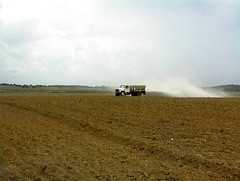Fall/winter the time to lime pastures to correct pH levels
FAYETTEVILLE, Ark. – The correct pH levels are essential to ensuring healthy pastures, and fall and winter are the right seasons to combat soil acidity, said Dirk Philipp, assistant professor for the University of Arkansas System Division of Agriculture.
“In parts of Arkansas, pH of pastures can easily be 5.5 or even lower,” he said. “Soils become acidic over time when the alkaline cations, such as calcium, magnesium, or sodium leach out and are replaced with hydrogen, an acidic cation.”
Philipp said that when the pH sinks below 5.5, nutrients such as nitrogen, phosphorus, and potassium become less available to plants, and the effectiveness of fertilizer is reduced.
At lower levels, phosphorus can bind with aluminum, keeping the plant from absorbing the phosphorus. Overall fertilizer efficiency is reduced at lower pH levels. Many forage species, notably legumes, are sensitive to acidic soils and those same low pH levels can favor weeds.
Ideally, a neutral pH is the best bet for pasture plants. “Phosphorus is most available to plants when the soil pH is between 6.0 and 7.0,” he said.
Soil tests, taken every other year, will enable growers to know their pasture’s pH. Growers should keep in mind that “if soil tests call for increasing the pH, it will take at least six months or even longer to elevate the pH,” Philipp said.
What lime to use?
In terms of lime sources, dolomitic lime contains more magnesium and may be used if magnesium concentrations in the soil need to be corrected. On the other hand, if magnesium isn’t a problem, then calcitic lime sources work as well, he said.
When it comes to application principles, growers need to keep this in mind:
- Lime calculations are based on correcting pH in the top 6 inches of the soil.
- Deeper tillage, such as in row crop systems, mix calcareous soils into the top soil and keep pH longer.
- In pasture systems with essentially no tillage over long periods of time it is crucial to monitor soil pH regularly as pH may drop more quickly than in pastures.
- Frequent fertilizer applications combined with surface-applied lime may reduce pH much quicker than in a row crop/tillage operation.
How frequently should lime be applied?
Philipp said if soil is tested regularly, the test reports will tell whether to apply lime or not, and says attention should be paid to the cation exchange capacity, or CEC.
“In a soil with less CEC, it should take less lime to correct pH but lime has to be applied more often,” he said. “In a soil with high CEC, larger quantities of lime may be required to correct the pH, but the pH will stay in the desired range much longer.”
If you would like more information on forages or livestock contact your county extension office or visit us online at www.uaex.uada.edu.
Pursuant to 7 CFR § 15.3, the University of Arkansas System Division of Agriculture offers all its Extension and Research programs and services (including employment) without regard to race, color, sex, national origin, religion, age, disability, marital or veteran status, genetic information, sexual preference, pregnancy or any other legally protected status, and is an equal opportunity institution.
By Mary Hightower
The Cooperative Extension Service
U of A System Division of Agriculture
Media Contact: Mary Hightower
Dir. of Communication Services
U of A Division of Agriculture
Cooperative Extension Service
(501) 671-2126
mhightower@uada.edu
Related Links
